Late clock-ins are annoying, but no-call no-show incidents are costly — especially for small business owners.
A single sick day can hurt your bottom line. In fact, US businesses lose $1 billion per week to insurance costs.
When someone misses their shift, you scramble to find a replacement. Meanwhile, you reluctantly pass their work onto another employee’s plate.
So, how do you address no-show no-call cases?
To answer this question, we’ll explore the impact of no-call no-shows and the best preventive solutions.

What does a no-call no-show mean?
A no-call no-show (NCNS) happens when an employee fails to appear at work without prior notice.
An unreported employee absence can be a one-time incident with a valid reason. However, repeated absences should raise flags for managers — they can lead to:
- Workplace absenteeism (employees habitually missing work),
- Project delays,
- Lost revenue,
- Disrupted workflows,
- Overburdened teammates, and more.
Track absences and work hours now
The stats also reveal a troubling trend: The latest survey by the US Bureau of Labor Statistics showed that full-time workers miss about 3.2% of their workdays.
Most employers can lay off team members for an unapproved no-call no-show, even though it’s not covered by federal law. Still, you should check local laws for any exceptions to avoid legal trouble.
For instance, the Washington State Department of Labor and Industries says that employees earn at least 1 hour of paid sick leave for every 40 hours worked. Yet, they aren’t required to notify their supervisor why they’re taking sick leave — whether it’s for themselves or a family member.
To reduce no-shows and related issues, create your own no-call no-show policy. Consult with an employment attorney or your local Department of Labor to ensure you don’t violate any labor laws.
💡 CLOCKIFY PRO TIP
To catch early warning signs of absenteeism, start monitoring employee attendance:
Why do no-show no-calls happen?
To prevent unplanned absences, you should understand why they occur. This deep dive excludes traffic accidents and other unpredictable events.
A 2024 hiring trends survey of 1,000 UK decision makers showed an increase of 41% in sick leave over 3 years. In fact, participants blamed company culture and employee happiness for excessive absence. Moreover, 55% of them reported poor business performance, pointing fingers at:
- Heavy workload,
- Difficulty hiring talent,
- Dependence on temporary workers,
- Low employee morale, and
- Increased absenteeism.
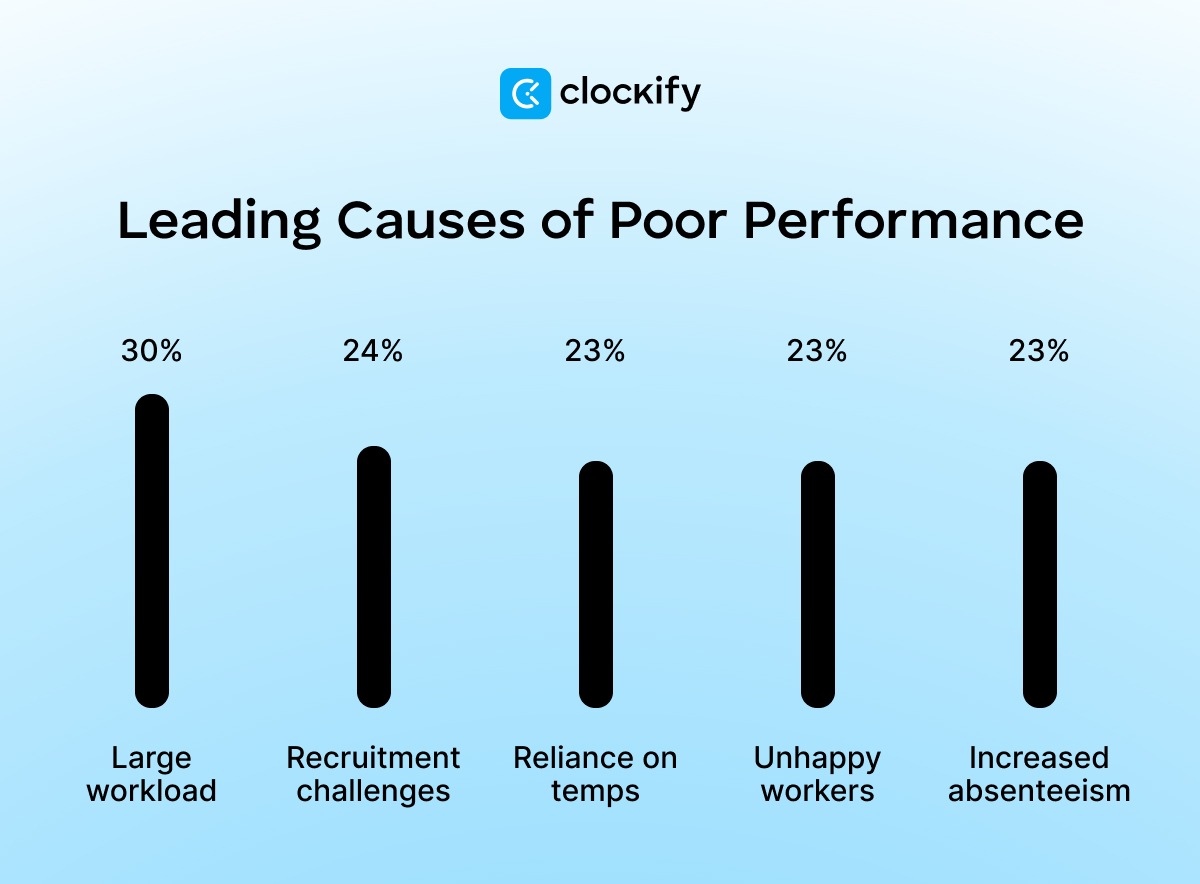
Executive coach Bill Berman recommends creating a safe space where staff, including managers, can feel comfortable admitting their struggles — before they escalate:

“We implemented ‘check-in protocols,’ where managers proactively reached out when they sensed stress, reducing no-shows by 75%. The key was training leaders to spot early warning signs — missed meetings, delayed responses.”
Additionally, tracking employee hours can help leaders pinpoint performance issues — from falling efficiency to diminished profits. With dependable time trackers like Clockify, you’ll know who needs extra support to minimize financial losses and employee burnout.
💡 CLOCKIFY PRO TIP
To fend off absenteeism and stay on top of your business, start monitoring work time with Clockify. Here’s all you need to know:
How to manage no-call no-show cases
When an employee is absent from work, they may be disciplined according to company policy. Employers can even fire their staff for unjustified absences.
To better address no-call-no-shows, we suggest following these steps:
- Inform your HR team and try to reach your employee by phone or email,
- Call their emergency contact if they don’t respond within an appropriate time,
- Find out why your employee is absent (if possible),
- Offer help if the employee has an urgent or welfare issue,
- Find a replacement or hand over tasks to a teammate,
- Document the absence in the employee’s file, and
- Take disciplinary action based on company policy if the absence is unjustified.
Before you take disciplinary steps, consider the reason for missed work and the employee’s past attendance record. A simple time tracker like Clockify can help you quickly review attendance reports.
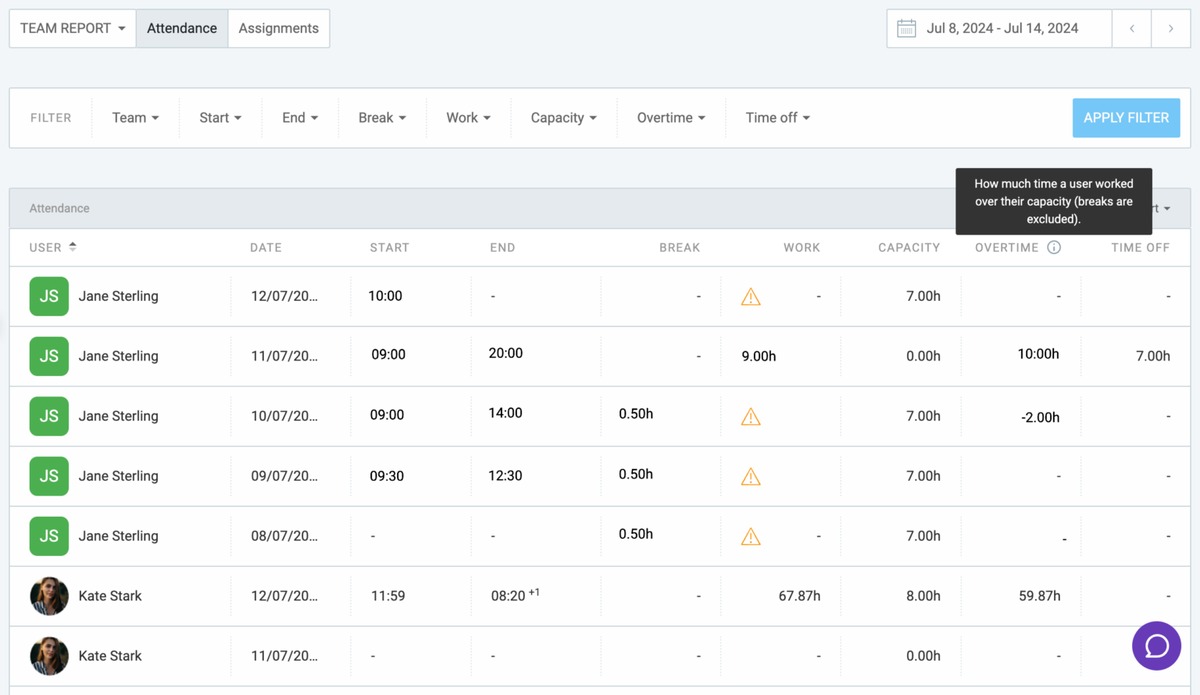
Check attendance logs with Clockify
If your worker has a history of poor attendance, arrange a meeting with them to discuss their behavior and corrective actions.
This step-by-step approach can help you increase employee accountability while protecting your company’s bottom line.
💡 CLOCKIFY PRO TIP
Time theft comes in many forms, including unexcused absences. Learn how to safeguard your business profits from time theft:
Implement a no-call no-show policy
An effective no-call no-show policy sets clear rules and consequences for missing work without prior approval. Furthermore, a compliant attendance policy helps supervisors avoid legal issues and stay consistent, while outlining expectations for team members.
As part of the overall attendance policy (or rules for employee presence at work), a no-call no-show protocol should clearly define:
- No-call no-show meaning,
- Valid and invalid reasons for unapproved absences, and
- Disciplinary measures for no-call no-shows.
Founder at an HR solutions company, Sophia Pettey, stresses the importance of having a clear NCNS process for fairness:

“I’ve seen employers fire someone for ghosting work, but not document it well or apply the same policy to someone else. Later, the employee came back with a complaint, saying it was unfair or discriminatory.”
Log time for workplace fairness
Benefits of having a no-call no-show policy
A well-communicated NCNS policy comes with valuable perks:
#1: Improved productivity — unplanned absences put pressure on your team, resulting in stress and overwork. Luckily, you can significantly reduce the chances of no-call no-shows with a simple protocol, leading to better employee productivity.
This way, you encourage workers to focus on personal tasks rather than juggle both their own and their teammates’ to-dos.
#2: Preventing system abuse — staff can easily exploit a system with no consequences. An NCNS policy holds them responsible for calling in when they’re unable to work.
#3: Saving money — finding a replacement and delaying tasks will hurt your wallet unless you’re prepared. So, a no-call no-show policy safeguards your company’s profits and workflow from:
- Overtime costs — employees may have to work overtime to cover the shifts of their absent teammates, increasing labor costs.
- Replacement costs — costs of hiring temps or dividing workloads among your staff to cover for absentees.
- Costs of absenteeism — negative effects of absenteeism extend beyond low productivity, impacting the work environment and work quality, e.g., the quality and delivery of services.
Schedule tasks ahead with Clockify
💡 CLOCKIFY PRO TIP
Stay on top of overtime costs with our free overtime pay calculator:
How to create a no-call no-show policy
Now let’s build a no-call no-show policy for your team — one step at a time.
Step #1: Define the policy’s purpose
Clearly state the purpose of the policy to ensure that workers understand the expectations and consequences of going AWOL.
Though expectations vary by company, they’re typically related to employee punctuality, regular attendance, and timely notification of absences.
Step #2: Explain what counts as a no-call no-show
Define what constitutes a no-call no-show — i.e., “an employee who doesn’t show up for their scheduled shift without prior notice.”
As mentioned before, the number of no-call no-shows before termination isn’t fixed. So, choose a suitable time frame to protect your company’s interests and workplace culture.
In the US, no laws dictate how late an employee can arrive at work. However, the OPM states that a tardy employee may be placed on administrative leave — a temporary suspension from work. Depending on your company policy, you can later classify the incident as a no-call no-show or a justified absence.
Catch late clock-ins with Clockify
If you’re unsure about any legal boundaries, make sure to consult with your HR team.
To avoid misunderstandings, you should communicate the NCNS rules clearly and directly — whether it’s through:
- Employee handbook,
- In-person meeting, or
- Company-wide email.
You can also invite employees to ask questions about the policy for extra clarity.
Here’s an example of a transparent no-call no-show policy, which covers all the necessary steps.

⬇️ Get FREE No-call no-show policy template (Google Docs)
Step #3: Outline the process for proper notification
The protocol should specify acceptable notice times and methods that employees should use to report an absence. To illustrate, this part should list:
- Who to contact (e.g., the HR team),
- How to contact (e.g., via phone, email, text, or in person), and
- Required notice period (e.g., 24 hours in advance).
With the accessibility of work chat apps like Pumble, your staff should be able to notify their absence hassle-free.
Step #4: Lay out the disciplinary procedure
Detail the consequences for no-call no-show offenses, such as:
- Verbal warning for the first occurrence,
- Written warning for the repeated violation,
- Pay suspension after the third offense, and
- Employee termination following the fourth incident.
While verbal reprimands are optional, the written warning (also called a no-call no-show write-up) is essential for documenting attendance issues and figuring out consequences. The no-call no-show write-up should include details, like:
- Employee info,
- Date of the incident,
- Summary of the incident,
- Policy that was violated,
- Future expectations, and
- Repercussions for repeated offences.
To help you avoid the hassle of writing a warning letter, we drafted a free printable sample — see image below.
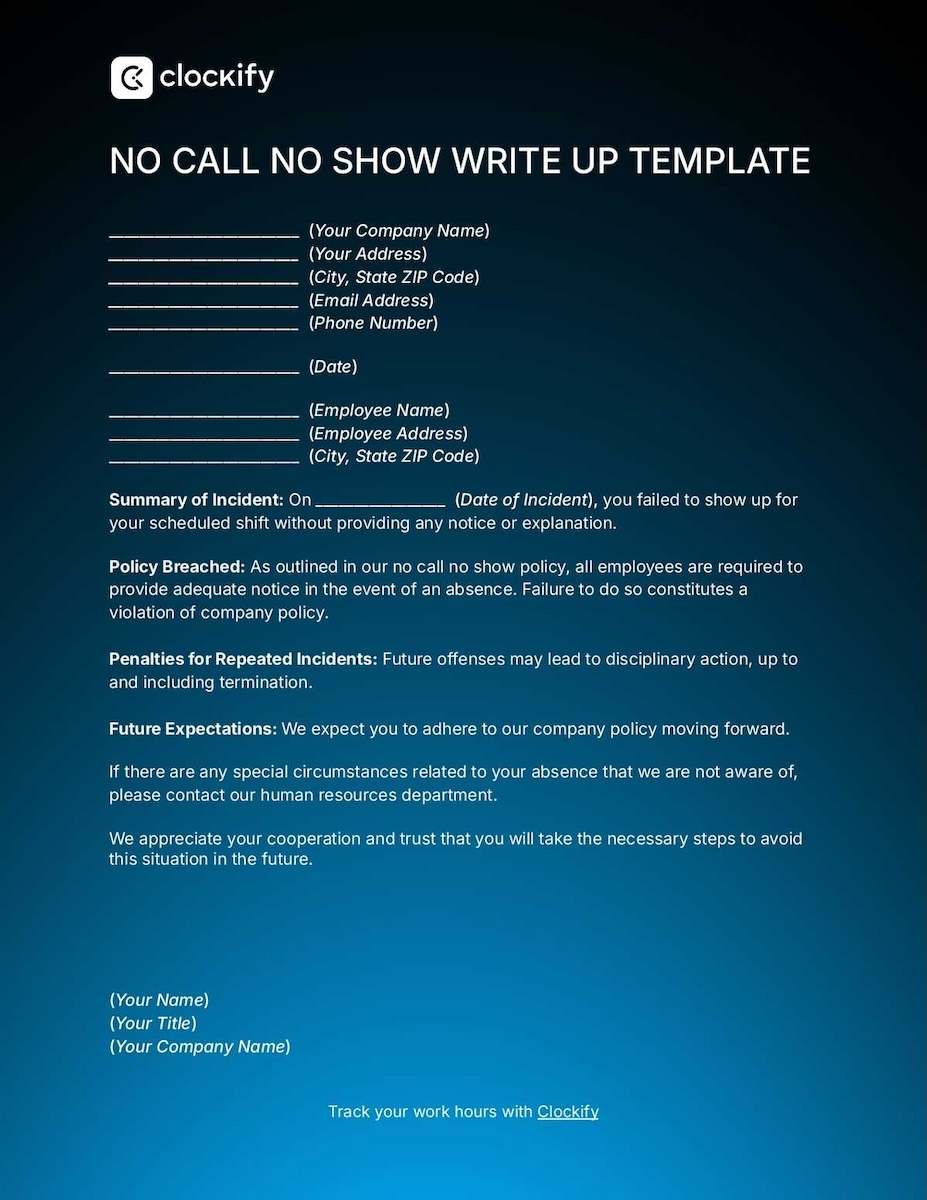
⬇️ Get FREE No-call no-show write-up template (Google Docs)
But disciplinary action extends beyond unreported absences. Based on the US Department of State’s information on employee conduct, you can apply the same measures to other types of misconduct, including:
- Repeated tardiness,
- Leaving work without permission,
- Taking sick leave without a doctor’s note, and
- Blatant disregard for leave rules.
See employee hours and location now
Managers take different corrective actions, but you should proceed with caution. While building discipline and respect is crucial, you don’t want your efforts to backfire — causing resentment among staff.
💡 CLOCKIFY PRO TIP
Early clock-outs are as problematic as no-call no-shows — messing up project schedules, payroll, and more. Learn how to stop early leavers in their tracks:
Step #5: List excusable no-call no-shows
Make exceptions for emergencies or unanticipated circumstances, like:
- Extreme weather conditions,
- Personal or family health issues,
- Accidents causing injury, and more.
Bonus tip: While many unfortunate events are beyond your control, you can take the following steps to minimize workplace injuries:
- Introduce safety training and drills,
- Provide protective gear (e.g., first-aid kits and computer glasses),
- Conduct routine checks on office equipment, and
- Offer regular physicals for employees.
💡 CLOCKIFY PRO TIP
Despite all safety measures, occupational injuries still happen — which makes employees eligible for workers’ compensation insurance. Learn more in our article:
Step #6: Review and update the policy
Revise the policy regularly to reflect the latest company changes, state laws, and constructive feedback.
Getting employees’ perspectives on the protocol will ensure that they know their rights and responsibilities.
Furthermore, aligning company rules with current labor and timekeeping laws helps you stay compliant when enforcing your no-call no-show policy.
Step #7: Consider laws affecting your no-call no-show policy
Apart from staying informed about local, state, and federal laws, make sure your policy reflects the guidelines in the Fair Labor Standards Act (FLSA), which governs:
- Setting overtime pay,
- Working time regulations, and
- Employee time tracking.
💡 CLOCKIFY PRO TIP
Employee monitoring laws and privacy concerns can make time tracking tricky. Here’s how a compliant, employee-friendly tool can make all the difference:
Step #8: Write a termination letter for a no-call no-show
When your employee has a string of no-shows, the last resort is termination.
This means sending them a termination letter — an official document notifying the worker about the end of their contract, which can include:
- Contact info of the employee and the company representative,
- Date of termination,
- Date(s) of missed work,
- Reason for termination (referencing the policy breach),
- Final payment details, and
- Employee’s next steps (e.g., returning office equipment).
To make the termination process less uncomfortable, we created a free termination letter template — see below.
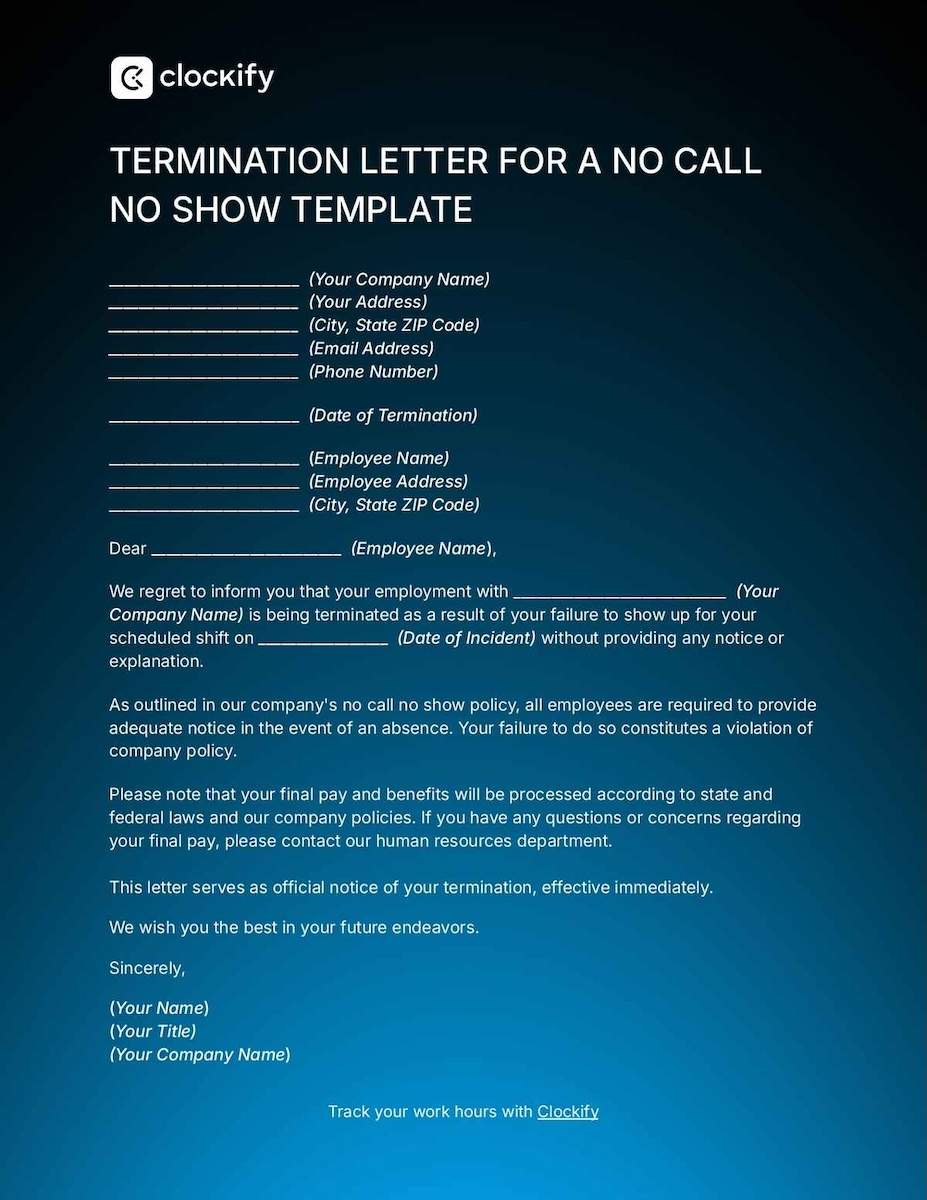
⬇️ Get FREE Termination letter template (Google Docs)
But why is issuing termination letters important?
Keeping a record of termination, along with previous warnings and disciplinary actions, helps you maintain transparency and dodge lawsuits.
💡 CLOCKIFY PRO TIP
To avoid the drama around employee termination, introduce responsible time tracking to promote positive work habits. Here are the most popular time tracking methods:
5 extra strategies to prevent no-call no-shows
Beyond the no-call no-show policy, you can try out other tips to limit unreported absences. Let’s get started!
Tip #1: Use a clock-in-clock-out app
A system for tracking work time and attendance can help you easily spot missing employees.
Lawyer Emma Alves illustrates how implementing solutions like clock-in apps can help you cut down on no-shows:

“Last-minute absence may be decreased by up to 40 percent by adding the text of shift confirmation or apps with check-ins.”
With a free and reliable time tracker like Clockify, you’ll always know whether your employees have punched in — thanks to the kiosk. You can quickly set up a shared kiosk that lets your employees enter personal PINs to clock in and out over their devices.
In particular, it lets supervisors like yourself see:
- Worker’s total time tracked,
- Their project activity, and
- User status.
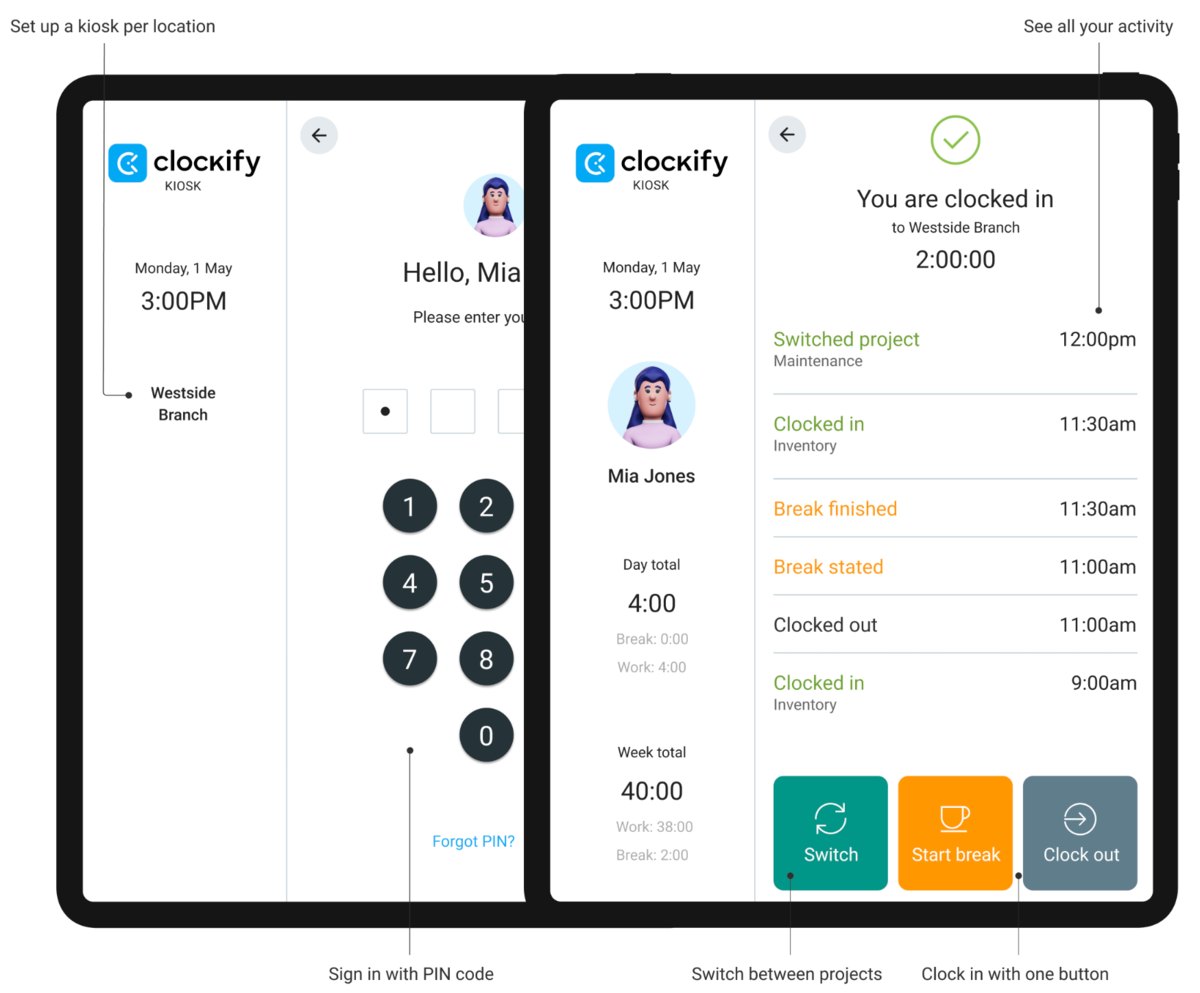
This strategy is not only employee-friendly and non-invasive, but also empowers managers to stay on top of attendance and scheduling issues.
💡 CLOCKIFY PRO TIP
Want to pick the best punch clock for your team? Here’s our breakdown of the most successful clock-in-clock-out systems:
Tip #2: Leverage a team chat app
A modern workplace should promote efficient communication to minimize no-call no-shows.
That’s where a team collaboration tool like Pumble shines, powering meaningful real-time communication among colleagues.
With our chat app, your employees can:
- Contact you at any time to report (last-minute) absences. They can even attach a document as written proof of their inability to come into work.
- Boost team engagement, resulting in better productivity. After all, a 2024 Employee Communication Impact Survey showed that in-house communication improves team connection for 74% of North American workers.
What’s more, you can effortlessly post company-wide updates, saving precious time on redundant meetings.
With a reliable communication system and strong work connections, no-call no-shows can become improbable.
Tip #3: Encourage open communication
Promoting honest communication makes your staff more comfortable when requesting time off.
For instance, employees will voice their needs more readily if you:
- Remind them regularly of their rights, and
- Offer help in the form of a heart-to-heart or a personal day.
This proactive approach to employee well-being fosters a supportive work environment where employees can freely communicate their needs. Meanwhile, they’re less likely to go missing without a word.
💡 CLOCKIFY PRO TIP
Clear communication can also persuade your employees to welcome organizational changes like timekeeping. Discover how to introduce time tracking without a hitch:
Tip #4: Reward positive work habits
Rewarding workers for good attendance is another effective way to bolster punctuality and prevent no-call no-shows.
A little generosity goes a long way in improving how employees feel about their work — which leads to better performance.
So, consider motivating your employees with incentives like:
- Tangible goods — e.g., gift baskets,
- Intangible rewards — e.g., employee recognition, and
- Monetary incentives — e.g., performance bonuses.
When it comes to using rewards to boost productivity, Forbes suggests that money is a powerful yet temporary motivator. On the flip side, psychological incentives (like public praise) ensure lasting job satisfaction and productivity — and they don’t cost a thing.
Track employee growth in Clockify
💡 CLOCKIFY PRO TIP
Incentives inspire employees to perform their duties even better — making your generosity worthwhile. Here‘s how to help your workforce thrive:
Tip #5: Track no-call no-show data for ongoing improvement
Tracking no-call no-show data can uncover absence trends and policy flaws. This helps team leads avoid headaches and stop revenue leakage.
To test your policy effectiveness, use a data-powered tool like Clockify to quickly spot patterns in employee behavior. The following flexible features should do the trick.
Feature #1: Attendance report — see when and how long your staff worked to gauge the frequency rate of absences. With insights into breaks and time off, you can easily monitor employee conduct.
Feature #2: Detailed report — filter data by employee and project to see who’s negligent about tracking hours and how they impact your daily operations. Accurate custom reports can help you pinpoint workers with time theft issues and repeated absences.
Feature #3: Project status — analyze estimated vs tracked time on ongoing projects for assigned employees. This may reveal changes in their work ethic that could lead to an absence — giving you time to step in.
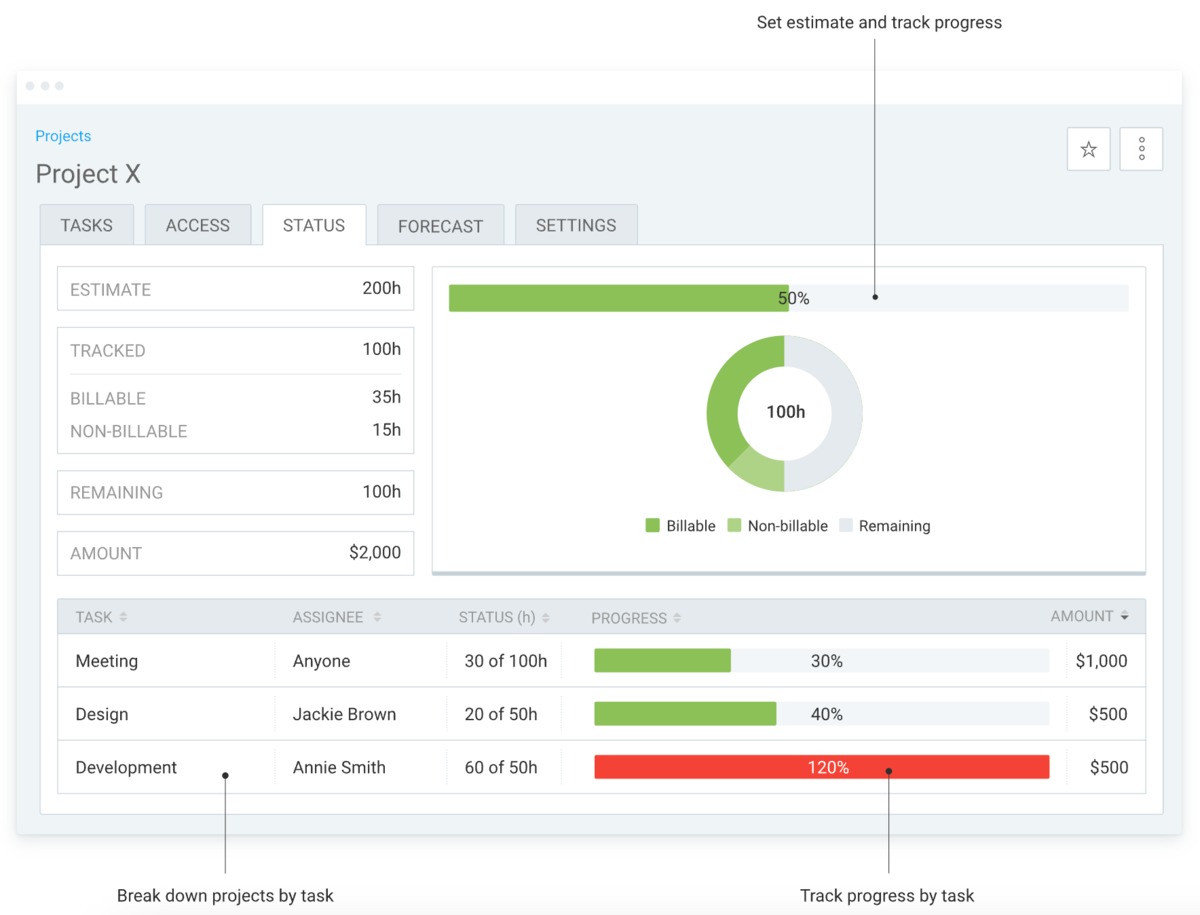
Eliminate task delays with Clockify
With Clockify’s comprehensive analytics, you can seamlessly record absences and make effective policy adjustments.
FAQs about no-call no-shows
Below, you’ll find comprehensive answers to the most common questions about missing work.
Is a no-call no-show considered job abandonment?
An isolated NCNS case doesn’t equal job abandonment.
However, multiple no-call no-shows without valid reasoning can fall under the job abandonment definition — not coming into work for several days without notice or intention of returning.
Generally, 3 consecutive days of unexcused absence can be considered job abandonment — allowing you to fire an employee.
Record missed days with Clockify
No federal law outlines the specific number of days. Still, for legal protection, you should define a reasonable time period and investigation process before ending someone’s contract.
💡 CLOCKIFY PRO TIP
Check and approve time off efficiently to ensure that nothing slips through the cracks. Follow our guide to create a reliable time off policy:
What no-call no-show excuses are valid?
Before you start handling unauthorized absences, you should understand what qualifies as a valid no-call no-show excuse and what doesn’t.
From a legal standpoint, the US government outlines several types of job-protected leave:
- Leave for family and medical reasons — Family and Medical Leave Act (FMLA) covers events, like childbirth or adoption, caring for a family member, or personal health issues.
- Court leave — Office of Personnel Management (OPM) states that employees summoned for jury duty are entitled to paid time off.
- Funeral leave — OPM grants employees paid leave to arrange or attend funerals of immediate relatives.
While federal law doesn’t cover emergencies, you should include them in your company policy among valid reasons to miss work — like car accidents or other life-threatening situations. After all, your employee may not be able to call in right away to explain what’s happening.
Track attendance with Clockify
Our expert interlocutor, Sophia Pettey, lists invalid no-call no-show excuses and explains that people need to communicate whatever happens:

“I’ve heard all kinds of reasons for missing work — ‘My alarm didn’t go off’ or ‘I was out late the night before.’ Without a line somewhere, the whole team starts to feel it.”
Beyond that, clear guidelines on acceptable and unacceptable excuses help managers ensure fairness and consistency. This can uplift employee morale and discourage unreported absences in the future.
💡 CLOCKIFY PRO TIP
Though no-call no-shows are a problem, false alarms do happen. If your employees attend work but frequently forget to clock in and out, here’s how to discourage that:
Maintain team attendance effortlessly with Clockify
Team leaders are always on the hunt for ways to automate grueling administrative tasks — like handling attendance issues. To discourage no-call no-shows, time trackers like Clockify by CAKE.com remain your best bet.
Our affordable tool offers a practical approach to managing disruptive no-shows for any business — with 2 features:
- Summary reports — get a quick rundown on employee activity for a specific time, with filters for projects, clients, and billable status. They’re a smart shortcut to identifying behaviors that go against your company policy.
- Targets and reminders — set time tracking targets for individuals or teams to stay ahead of their schedules. Employees who miss their targets will automatically receive email reminders.

In turn, you’ll get missed target reports for underperforming employees. This can serve as written proof of actual time worked — as shown in the image below.
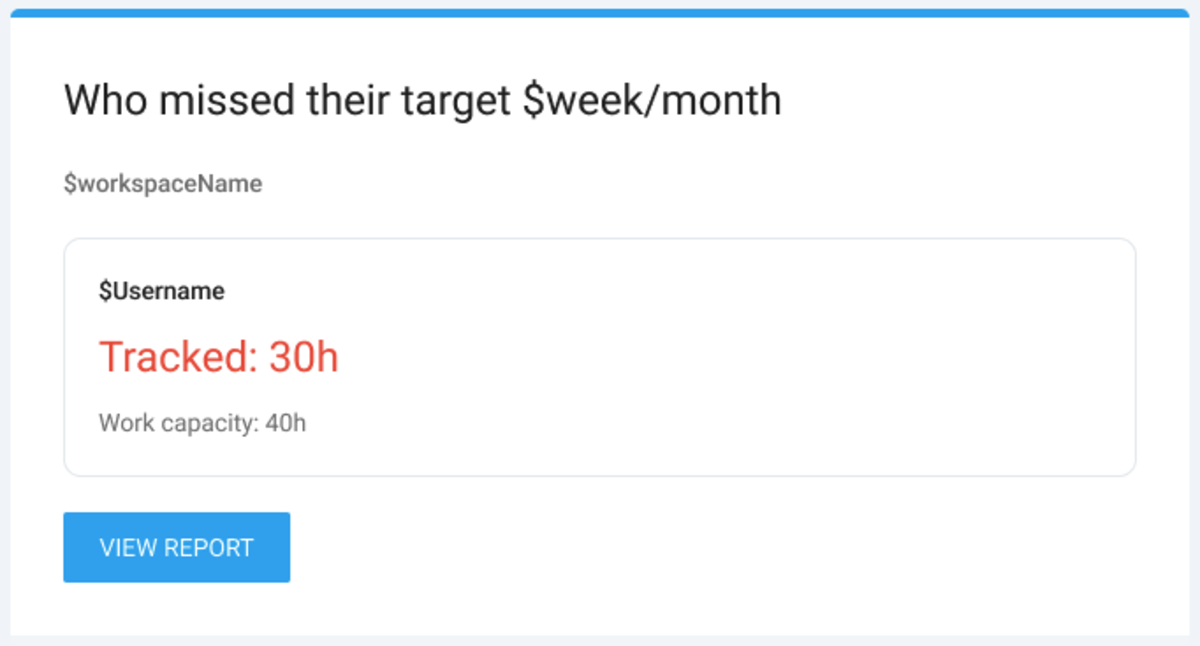
With Clockify, you can tackle attendance issues confidently. Our free account covers basic time tracking and billing functionalities, with around-the-clock customer support.
Beyond the basics, you can browse our CAKE.com Marketplace add-ons for further customization.
For more advanced attendance tracking, upgrade your plan to get features like bulk editing and kiosk PINs for just a few bucks. Paid users also enjoy 1-on-1 onboarding — free of charge.
With Clockify-powered workflows, no-call no-shows and delays are unlikely — ensuring accurate, compliant payroll and billing.
REFERENCES
License for research — Work absenteeism and its impact on productivity in the administrative area: https://creativecommons.org/licenses/by/4.0/




